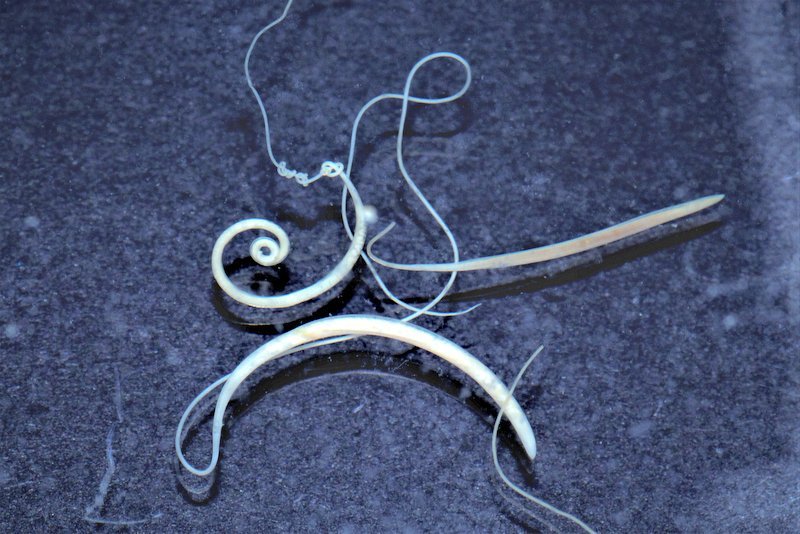
In this piece, we’ll dive into their favorite environments, what makes these spots ideal for whipworms, and why it matters to us as we consider animal health and disease management. Picture it like a treasure map, where each location serves a unique purpose for the whipworm’s life cycle.
What Is a Whipworm?
Before we explore their habitats, let’s get a clear picture of what whipworms are. The most well-known whipworm is *Trichuris trichiura*, which primarily affects humans. These worms are characterized by their whip-like shape, which is where they get their name. Their body is narrow at one end and wider at the other, resembling a whip or a skipping rope.
Whipworms are part of a group of parasites known as *nematodes,* and they can live in the intestines of their hosts for several years. They feed on the host’s blood and tissues, which can lead to various health issues, including diarrhea and abdominal pain. Understanding their habitat is crucial, as it informs us about the conditions that promote their survival and spread.
Natural Habitat: Where Do They Live?
Whipworms prefer moist, warm environments, often found in areas with rich organic matter. This means they thrive in places like:
- Soil enriched with human and animal feces
- Gardens and agricultural fields
- Wetland areas with high levels of moisture
The ideal environment not only provides warmth but also offers a way for whipworm eggs to hatch and infect hosts. The presence of host animals is crucial in these habitats, as that’s where whipworms find their meals and continue their life cycles.
You might be wondering how these worms get into such environments. Eggs from infected hosts are expelled into the soil through feces. If the conditions are just right—warm and moist—these eggs can remain viable for a long time, waiting for a new host to come along.
Soil Conditions: The Perfect Playground
Soil is an essential factor in whipworm habitats. They thrive in soils that have:
- A pH level between 6.0 and 7.5
- Organic content that retains moisture
- Sufficient nutrient levels to support host populations
The reason whipworms prefer this type of soil is simple: it supports the life stages of their eggs. The eggs need a favorable environment to survive and must be ingested by a host to hatch. When whipworm eggs are in nutrient-rich soil, they have a better chance of infecting an unsuspecting host, continuing their life cycle.
Imagine a small army of invisible eggs waiting patiently for their chance to find a home. Moisture keeps them alive while the right nutrients help create ideal living conditions for their future hosts.
Host Animals: Finding Their Meal Tickets
Whipworms have a range of potential hosts, but they particularly like to inhabit certain animals. Their favorites include:
- Humans
- Dogs
- Pigs
- Primates
You might find yourself asking why they prefer these specific animals. Well, the anatomy and diet of these hosts create a perfect environment for whipworms. For example, human intestines provide a warm, nutrient-laden habitat, making it an ideal place for whipworms to live and reproduce.
When whipworms infest a host, they can often go unnoticed for some time, which complicates control efforts. This sneaky behavior allows them to thrive in environments where hosts are less likely to notice the problem until it becomes severe.
Environmental Factors: Temperature and Moisture
Temperature and moisture are critical players in whipworm habitats. They prefer environments where temperatures stay between 20°C to 30°C (68°F to 86°F). This range is not just about comfort but also about survival:
- Warm temperatures help accelerate the hatching of eggs.
- High humidity maintains soil moisture, essential for egg viability.
In a warmer climate, whipworm populations can increase significantly. The rainy season often brings an uptick in whipworm infections since wet conditions help maintain the ideal environment for their eggs and larvae.
It’s a bit like a garden flourishing after a rainstorm—everything grows and multiplies. The more favorable the conditions, the more whipworms can thrive, leading to higher infection rates within host populations.
Human Impact: How Urbanization Affects Whipworm Habitats
Urbanization has dramatically changed the landscape of whipworm habitats. As cities expand, natural environments are altered, often reducing the availability of suitable conditions for whipworms. Here’s how urbanization plays a role:
- Pollution can degrade soil health, affecting whipworm survival.
- Waste management issues can lead to localized increases in whipworm populations, as improperly disposed waste may provide fertile breeding ground.
- Increased hygiene practices have resulted in a reduction of whipworm infections, as better sanitation improves environmental conditions.
While urban development can diminish whipworm habitats, it can also create pockets where infection rates spike due to unsanitary conditions. It’s a mixed bag that shows how human activity can both help and hinder whipworm populations.
Understanding the habitat preferences of whipworms provides crucial insights into their life cycle and impacts on host health. From rich, moist soils to the types of animals they depend on, each aspect fits together like pieces of a puzzle.
As we learn more about these unique parasites, we can better manage health issues they cause, helping both human and animal populations. By keeping our environments clean and practicing good sanitation, we reduce the chances of whipworms finding suitable habitats.
In essence, you could say that our actions directly influence their survival. So, let’s keep our worlds clean—after all, keeping whipworms at bay is just as important as maintaining our health.

